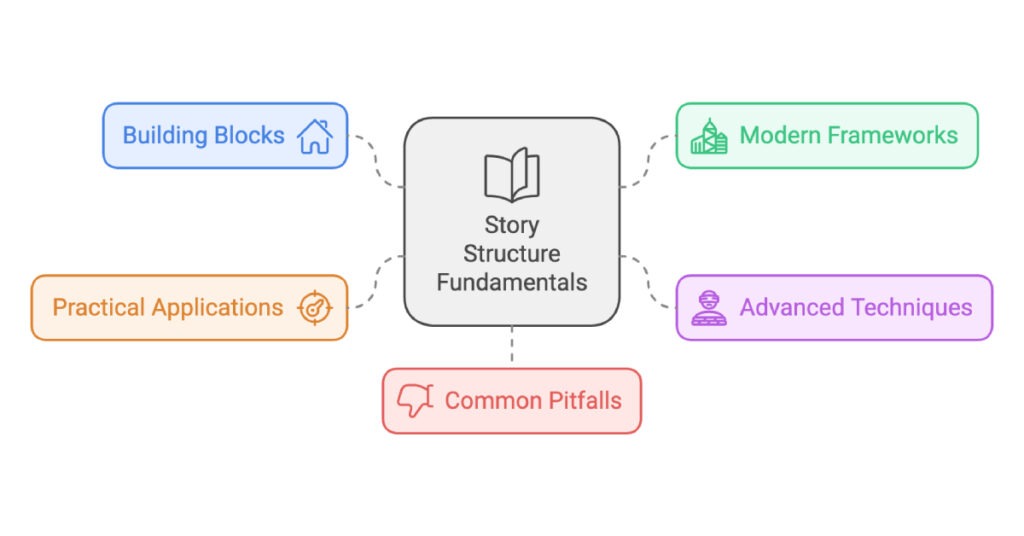Ever watched a tightrope walker? There’s something mesmerizing about their perfect balance – one slight misstep could send them tumbling, yet they glide across with seamless grace. That’s exactly what great storytelling is like. Behind every unforgettable tale, from Homer’s Odyssey to the latest Netflix binge-worthy series, lies an invisible tightrope: story structure.
I remember the first time this clicked for me. I was struggling with my own manuscript, drowning in a sea of plot points and character arcs, when my writing mentor dropped this truth bomb: “Stories are like skyscrapers – the public sees the glass and steel, but it’s the framework that keeps it from collapsing.”
Today, I’m going to show you how to build that framework. Whether you’re crafting your first short story or polishing your tenth screenplay, understanding story structure isn’t just about following rules – it’s about creating a foundation strong enough to support your wildest creative ambitions.
As the experts at Dabble Writer note, mastering story structure is like learning to cook. Sure, you could throw ingredients in a pan and hope for the best, but understanding the basic recipes first? That’s what turns kitchen disasters into culinary masterpieces.
Ready to transform your storytelling? Let’s dive into the architectural secrets that make stories stand the test of time.
The Building Blocks of Storytelling
Let me tell you something funny – when I first started writing, I thought great stories just… happened. Like some authors had a special gene that made their words flow perfectly. Boy, was I wrong! As explained by the experts at Dabble Writer, story structure is actually more like a chef’s recipe than magical DNA.
The Classic Five-Act Structure
Think of this as the OG of storytelling frameworks:
- Exposition (The Setup)
- Rising Action (The Chase)
- Climax (The Peak)
- Falling Action (The Reversal)
- Resolution (The Wrap-Up)

Essential Elements of Compelling Stories
According to Reedsy’s comprehensive guide, every engaging narrative needs:
- A hook that grabs readers
- Strong character development
- Meaningful conflict and tension
- Engaging dialogue
- Theme and subtext
Modern Storytelling Frameworks
The Three-Act Structure
The Novel Factory highlights that most contemporary narratives follow this structure:
| Act | Portion | Purpose |
|---|---|---|
| Setup | 25% | World-building, character introduction |
| Confrontation | 50% | Main conflicts, character growth |
| Resolution | 25% | Climax and conclusion |
The Seven-Point Story Structure
For those who prefer more detailed planning, consider this framework:
- Hook
- Plot Turn 1
- Pinch Point 1
- Midpoint
- Pinch Point 2
- Plot Turn 2
- Resolution
Advanced Storytelling Techniques
Nonlinear Narratives
Nonlinear storytelling can add complexity and intrigue to your story. Think “Pulp Fiction” or “Memento” – these stories prove that breaking chronological order can create powerful narratives.
Genre Considerations
Different genres require different approaches to structure. A thriller might need faster pacing, while a character-driven drama might allow for more contemplative moments.
Practical Applications
For Screenwriters
If you’re writing for the screen:
- Use professional screenwriting software
- Understand TV vs. film structure differences
- Master formatting essentials
For Novelists
Novel writing offers more flexibility, but remember:
- Strong openings are crucial
- Character arcs should align with plot structure
- Pacing matters more than rigid structure
Common Pitfalls to Avoid
- Forcing your story into a rigid template
- Neglecting character development for plot
- Rush ing through important moments
- Avoiding necessary conflicts
Getting Feedback and Moving Forward
Success in storytelling often requires:
Conclusion
Story structure isn’t about following rules – it’s about understanding principles that make stories resonate. Whether you’re crafting the next great American novel or writing a screenplay, these fundamentals will serve as your foundation.
Ready to start writing? Remember: structure should support your creativity, not constrain it. Begin with these basics, then let your unique voice shine through.
Ready to put these principles into practice? Check out our screenwriting essentials guide for more detailed insights and start crafting your story today!
